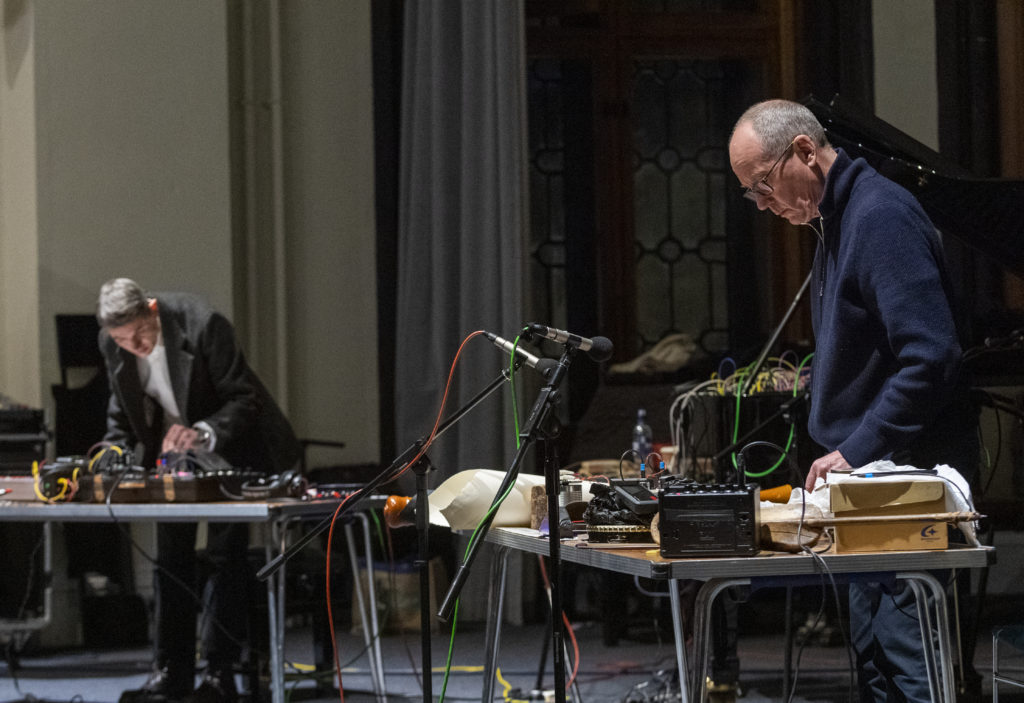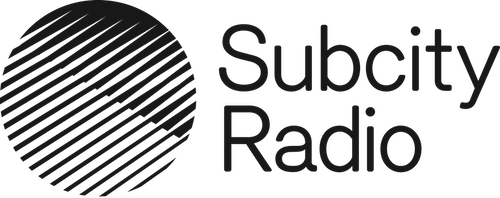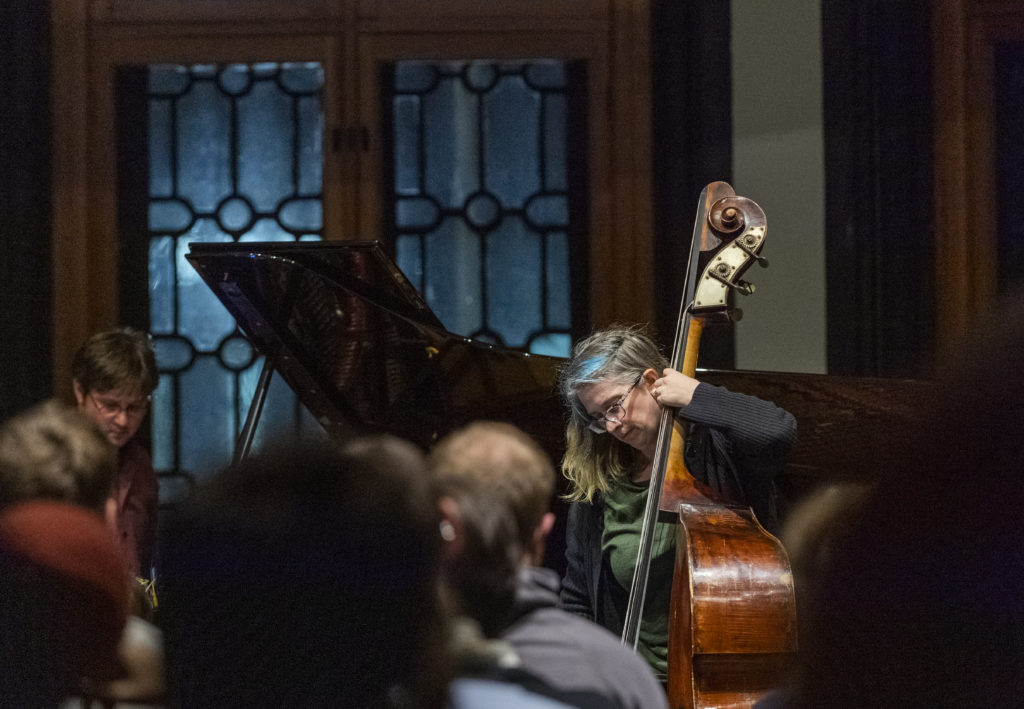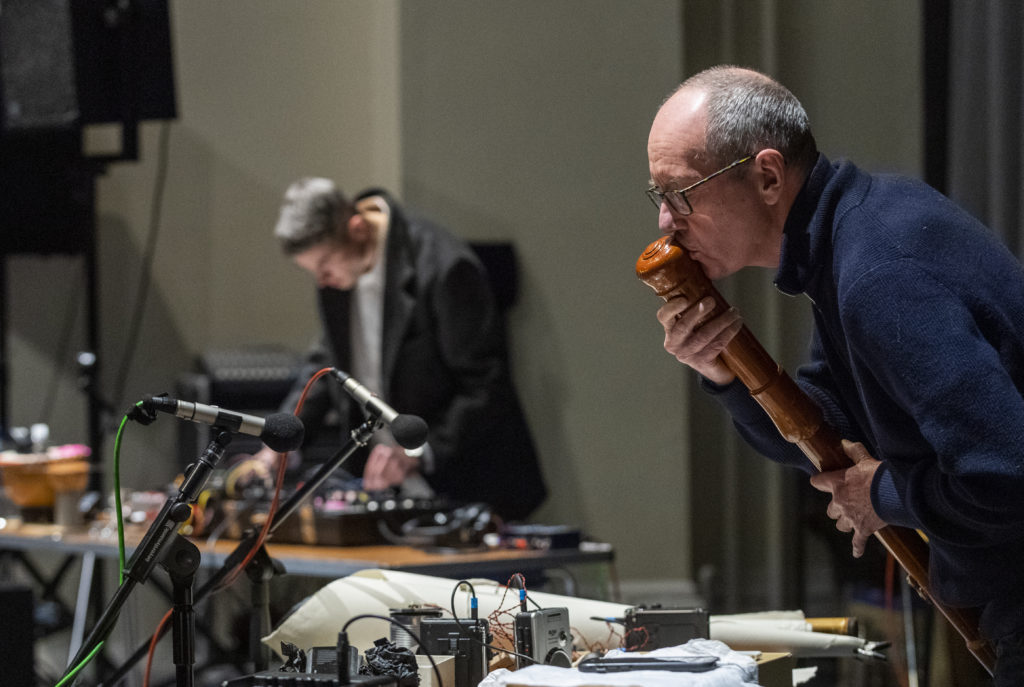
In February David Toop visited the University of Glasgow as its 2020 Cramb Resident in Music. Musician, innovator, author, curator, and Professor of Audio Culture and Improvisation at the University of the Arts London, Toop led a series of events during this residency on the theme of Listening. Postgraduate student Beth Horseman reflects on this visit, its echoes and inspirations, which continue to resonate during the current lockdown.
It was back in the year 2000, on the precipice of a new millennia, that David Toop wrote:
[…] we humans are busily constructing an environment that marginalises our own corporeal presence. Our fingers no longer grip; they click and drag. For better or worse, the 21st century promises to be an aetherial landscape of images, sounds and disembodied voices, all connected by invisible networks and accessed through increasingly transparent interfaces.
Toop, D., 2019. Inflamed Invisible: Collected Writings on Art and Sound 1978-2018.
London, England: Goldsmiths Press
These three lines, published several years before the founding of MySpace or Facebook, take on new meaning through the lens of the present lockdown. With corporeal presence all but removed as an option for our work, academic and social existences, even those who had avoided online personas into the 2020s have recently found themselves resorting to these networks and interfaces as the newly predominant mode of social interaction. Perhaps more than ever these words – written to accompany the UK’s first major sound art exhibition, curated by Toop – demonstrate the prophetic and poetic capabilities Toop displays when writing on the cultural zeitgeists of the 20th and 21st centuries.

Flash forward to February 2020 when Toop visited the University of Glasgow as this year’s Cramb Resident in Music, and the themes of listening and engagement are as relevant as they ever were. In addition to a series of public events held during his residency to offer insight into Toop’s writing, listening, and performing practices, fellow students on the MSc in Sound Design and Audiovisual Practice were given the opportunity to meet with him over lunch. Walking down Great Western Road the next day to pick up the person whose disembodied musings I had read so much felt surreal, but when we reached the hotel Toop was revealed to be a pleasant walking companion whose unhurried and considered speech made for easy conversation, equally comfortable in the roles of interviewer and interviewee. These skills were later displayed during a seminar on Toop’s seminal work Rap Attack; a book published in 1984 which explored the birth of New York’s hip hop scene through in-depth interviews and tracings of the genre’s many musical roots. Discussion of the music industries at the time of writing must lead to a consideration of issues surrounding race and gender equality, and conversation soon turned to navigating the fresh perspectives offered by the #MeToo movement on musicians previously entrenched in the cultural canon.
That same day, framed by the gothic arches of the University’s Concert Hall, the Cramb Concert was held. A selection of artists performed various experimental improvisations, with a collaboration between David Toop and Turner-prize-nominated artist Luke Fowler serving as the headline act.
The first act offered up varying sound textures as Una McGlone explored the full timbral range of the double bass and Sebastian Lexer merged concert piano, live sampling and other sounds in a fascinating electroacoustic improvisation. Ute Kanngiesser gave an ethereal performance on the cello, which explored rich harmonics, overtones, and bowing/pizzicato techniques to airy effect. For Toop and Fowler’s performance, two tables littered with curios were brought to the front of the stage area and the free improvisation which followed was as intriguing to watch as it was to hear. In recent decades Toop’s practice has explored boundaries between listening, sound, materiality, and music, with a frequent focus on sounding objects: the performance incorporated these themes with sonic complexity. Bone conduction transducers, among other techniques, were used to convert different artefacts into speakers, in turn affecting the sound of the tapes being played through them. The result was a sort of sonic show-and-tell which took the audience through soundscapes of changing familiarity and intensity. Listened to retrospectively, the ambiguity of the sounds takes on new power whilst ideas of sonic composting, as discussed by Toop, become audible as sounds ‘fertilise’ other sounds.

https://www.subcity.org/shows/subcitypresents/873b3
The final event of the residency was Toop’s answer to the public lecture, reframed as a ‘long table’ discussion. Modelled on Lois Weaver’s engagement practices, the aim was to move away from the traditional lecture towards a more equitable discussion, open to students, academics and musicians alike. An introductory performance of ‘Table Manners’ opened the process of considering sounds and the personal meanings, values, or boundaries we attach to them. Coming and going from the table was encouraged, all welcome to join or leave the discussion as they saw fit. The result of this experiment was an engaging marathon of a conversation, clocking in at just under two hours, which traversed areas of listening and composition with a focus on the reception and modes of both. Conversation was lively, with many breaks for laughter, and gave much inspiring food for thought. It struck me as interesting and apt that, as the conversation’s initiator, Toop himself chose to move away from the table into the role of spectator, of listener.
Looking at Toop’s eclectic path of careers, which have spanned some of the most formative decades for contemporary and experimental music, a common theme emerges: he is someone who pays attention to things. Through his work engaging with and responding to his immediate and cultural surroundings, Toop has amassed stories and sounds which – although gathered over the course of decades – weave together new, often unexpected meanings and revelations. More than ever during this period of lockdown, when we find more creative output flooding the internet than ever before, I am reminded that it is ok not to feel the pressure to increase your own output, to shout – as it can sometimes feel – into the void. Maybe it is best instead to choose to listen, to contemplate your own environments – both cultural and physical – and see where these routes of inquiry might lead you.
Beth Horseman is a student on the University of Glasgow’s MSc in Sound Design and Audiovisual Practice. She is on the organising committee for Sound Thought, a Glasgow based festival of Postgraduate music & sound research, and a member of the team at Subcity radio, a non-profit, independent station based in Glasgow and broadcasting to the world.
The Cramb Lecture and Residency in Music annually invites a visiting lecturer, pre-eminent in the field of Music, to the University of Glasgow for an inspiring series of seminars, workshops and performances. For more information visit: www.gla.ac.uk/cramb
In 2020, the residency was co-presented as part of the Material/Immaterial programme at the School of Culture and Creative Arts.






